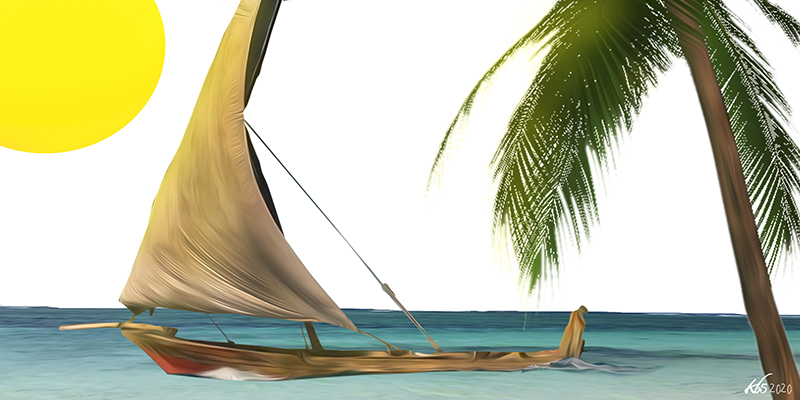Five scientists, Joyce Kerubo, John M. Onyari and Agnes Muthumbi from the University of Nairobi, Deborah Robertson-Andersson from the University of Kwa Zulu Natal, and Edward Ndirui Kimani from the Kenya Marine and Fisheries Research Institute (KMFRI), undertook a research study last year that returned a harsh verdict of a high presence of microplastics (MPs) in Kenya’s Indian Ocean.
MPs are plastic pellets, fragments, and fibres that enter the environment and are less than 5mm in dimension. The primary sources of MPs are vehicle tyres, synthetic textiles, paints, personal care products, and plastic products that have disintegrated into tiny particles because of environmental turbulence.
The study by the five scientists, Microplastic Polymers in Surface Waters and Sediments in the Creeks along the Kenya Coast, Western Indian Ocean (WIO), identified four polymer types in Kenya’s Indian Ocean. High-density polythene is the most abundant at 38.3 per cent, followed by polypropylene (34.6 per cent), low-density polythene (27.1 per cent), and medium density polythene (17.1 per cent). The research findings were published in the European Journal of Sustainable Development Research on 18 October 2021.
The concentration of MPs in the surface waters along the Kenyan coastline was higher compared to other parts of the world, the study warned. The findings of the study also confirmed those of previous studies on the presence of MPs in Kenya’s Indian Ocean.
The scientists also cautioned that the documented information on the specific polymeric composition of these particles in seawater and in the sediments along the Kenyan coast was insufficient. The findings, the study offered, demonstrated the extent of exposure to MPs in Kenya’s ocean ecosystems, therefore justifying policy intervention in the management and disposal of plastic waste, and the protection of the ocean’s rich biodiversity for sustainable development.
It drew testing samples from three creeks: Tudor and Port Reitz in Mombasa County and Mida in Kilifi County. Tudor Creek covers an area of approximately 20 square kilometres and is fed by two seasonal rivers—Kombeni and Tsalu—that originate around Mariakani, about 32 kilometres northwest of Mombasa. The two seasonal rivers collect runoff containing plastic and other waste from the mainland and discharge it into the creek.
Surrounding Tudor creek are several densely populated informal settlements that include Mishomoroni and Mikindani that may add MPs to the ocean. According to the study findings, the majority of the MPs were fibrous materials from textiles and ropes, probably from wastewater from washing clothes and from fishing activities.
Other key facilities that could contribute to the pollution include shipping activities at the Port of Mombasa, meat processing at Kenya Meat Commission (KMC), Coast General Hospital, Container Freight Stations (CFSs) and Kipevu Power Station. Before it was rehabilitated, Mombasa County Government dumped a lot of waste at Kibarani, near the two creeks and just next to the ocean.
Tudor Creek recorded the highest pollution, also as a result of rain runoff from Kongowea market and Muoroto slums, and Mikindani sewage effluent. Moreover, according to the study, which could, however, not determine the proportions, many industries on Mombasa Island release their effluent into the sea, increasing MPs in sediments.
Mida Creek was used as a control in the study as it does not have river inflows. In addition, the creek is in a marine reserve that forms part of the Watamu Marine National Park and Reserve. However, MPs from different polymers were found in sediment and surface water samples from all the sites—including Mida Creek which is within Watamu National Marine Reserve—which the researchers had thought to be safe from pollution by industrial effluent, sewage disposal, and fishing activities.
Many industries on Mombasa Island release their effluent into the sea, increasing MPs in sediments.
The study attributed the pollution at Mida Creek to high tourism activities, boat and dhow fishing activities, densely populated villages such as Dabaso, Ngala, and Kirepwe and the mangrove vegetation cover of tall trees that binds soil particles thus favouring the accumulation of MPs.
According to a United Nations Environment Programme (UNEP) report released in March 2019, plastic—which makes up a sizable proportion of marine pollution—can now be found in all the world’s oceans, but concentrations are thought to be highest in coastal areas and reef environments where the vast majority of this litter originates from land-based sources.
In Kenya, daily plastic consumption is estimated at 0.3 Kilograms per person. In 2018, Kenya imported between 45,000 and 57,000 metric tonnes of plastic.
Earlier in 2020, KMFRI had carried out its own study—Microplastics Pollution in Coastal Nearshore Surface Waters in Vanga, Mombasa, Malindi and Lamu, Kenya—that painted an even gloomier picture of MP pollution.
The four sampling locations represented the South coast, Mombasa and the North coast of Kenya’s coastal nearshore waters, and looked into considering fishing, recreation, and industrial activities, as well as the municipal effluent that finds its way into these target areas.
The objective of the study was to assess the abundance MPs and their composition in Kenya’s coastal near-shore waters during the two rainy seasons at the Kenyan coast: the north-east monsoon which runs between November and March, and the south-east monsoon which runs from April to October.
The results showed a widely varied distribution of MPs between the two seasons, with the overall highest concentrations occurring during the south-east monsoon when surface runoff from rainwater and from effluent from the major towns is high.
As confirmed in other research studies, the concentrations recorded by KMFRI, were quite high compared to other parts of the world. This provided baseline data for MPs, showing that population, anthropogenic activities and seasonal variations a play key role in influencing pollution by MPs.
Total MP concentrations in all the study areas during the north-east and the south-east monsoon seasons ranged between 83 MPs/m³ and 8266 MPs/m³ and between 126 MPs/m³ and 12,256 MPs/m³ respectively, with a mean of 3228 MPs/m³. The highest microplastic levels were found in Mombasa at 12,256 MPs/m³ during the south-east monsoon season, where runoff and effluent due to heavy rains are thought to be the primary source. The next highest levels were found in Malindi, occurring during the south-east monsoon season, because of inflows from River Sabaki.
Boat activities and tourism during the north-east monsoon season and runoff from the town during the south-east monsoon season mostly affected Lamu, while fishing activities, as well and runoff from the town, could be responsible for the abundance of MPs recorded in Vanga.
Solid waste management remains an enormous challenge in coastal towns, with Mombasa County facing the biggest challenge due to a burgeoning population. Although most of the solid waste generated in the county is organic—largely from households, hotels, restaurants and agricultural produce markets, the largest being Kongowea and Marikiti—plastic takes up a significant share.
In its County Sessional Paper No 01 of 2019, Mombasa County estimated daily waste production at 2,200 tons, 68 per cent of which is organic. Approximately 18 per cent of this waste is plastics, cardboard, paper and metals.
Other inorganic waste such as e-waste, construction waste and junk makes up an estimated 14 per cent of the waste generated. Public and private health facilities generate an estimated 2 to 3 tonnes of biomedical waste daily.
Solid waste management remains an enormous challenge in coastal towns, with Mombasa County facing the biggest challenge due to a burgeoning population.
Most of the solid waste generated is disposed in undesignated open grounds—in VOK, Kwa Karama, Kadongo, Junda, Saratoga, and Mcheleni. It is disposed in the same form as it is generated without being recycled or reused. Disposal of solid waste in the open has continuously had a negative environmental health impact through the contamination of water sources.
Moreover, with the limited investment in solid waste recycling and recovery systems, disposal methods in the county have been a contributor to public nuisance.
There are two designated dumpsites, namely Mwakirunge in Kisauni and Shonda in Likoni. However, these dumpsites are poorly managed and do not respect the prescribed environmental health standards while Mombasa County government’s budgetary allocation for solid waste management is not sufficient to meet the desired results.
MPs are harmful to human health, experts say. The ingestion of MPs by species at the base of the food web causes human food safety concerns, as little is known about their effects on the food that finally lands on our menu.
The minuscule size of MPs renders them invisible to filter-feeding fauna, leading to unintentional ingestion. In a study published in December 2020 in the Africa Journal of Marine Science, W. Awuor, Agnes Muthumbi and Deborah Robertson-Andersson confirmed the presence of MPs in marine life. The study investigated MPs in oysters and in three species of brachyuran crabs.
They did sampling in eight stations distributed between three sites—Tudor, Port Reitz and Mida Creek—in January and February 2018, during low spring tide. The sample comprised 206 crabs and 70 oysters.
The study identified MP fibres of different colours—red, yellow, black, pink, orange, purple, green, blue—as well as colourless ones. Colourless fibres were the most prevalent, comprising at least 60 per cent of the total MPs. The mean lengths of the MP fibres were between 0.1 and 4.2 mm.
The study exposes MP pollution along the Kenyan coast and its uptake by marine fauna, and thus strengthens the case for better control of plastic waste in the ocean. “Marine plastic litter pollution is already affecting over 800 marine species through ingestion, entanglement and habitat change,” said the head of UN Environment’s coral reef unit, Jerker Tamelander, in 2019.
“Waste continues to leak from land, and coral reefs are on the receiving end. They also trap a lot of fishing gear and plastic lost from aquaculture. With the effects of climate change on coral reef ecosystems already significant, the additional threat of plastics must be taken seriously.”
According to UNEP, there remains a significant lack of knowledge on the true impact of plastics on the reef environment, including the level of concentrations of MPs across coral reef eco-regions in order to understand the scale of the issue in a standardised manner.
“Marine plastic litter pollution is already affecting over 800 marine species through ingestion, entanglement and habitat change.”
Concerns about ocean pollution have been raised at a time when the country is looking at the Blue Economy as the country’s next economic growth frontier. In effect, Kenya’s land-based resources have been shrinking because of a rapidly growing population and it is therefore prudent for the government to shift the focus to the country’s ocean resources spread over an area of 245,000 km², or 42 per cent of the country’s total land mass.
Kenya has from the outset not been keen on growing the maritime sector. Even Kenya’s first independence economic blueprint, African Socialism and its Application to Planning in Kenya, published in 1965, failed to anchor the Blue Economy in the country’s economic growth agenda, despite its significant role in transporting 95 per cent of the country’s global transactions.
The Western Indian Ocean has resources worth more than KSh2.2 trillion in annual outputs, with Kenya’s share standing at about 20 per cent of this figure. The marine fishing sub-sector alone had an annual fish potential of 350,000 metric tonnes worth KSh90 billion in 2013. However, the region only yielded a paltry 9,134 metric tonnes worth KSh2.3 billion during that year.
In 2018, the then Agriculture Cabinet Secretary, Mwangi Kiunjuri, said that by failing to fully exploit the Blue Economy, Kenya was losing over Sh440 billion annually. But if the opportunities offered by the Blue Economy are to be exploited, a policy intervention in the management and disposal of plastic waste is urgently required to protect the ocean’s rich biodiversity for sustainable development.








